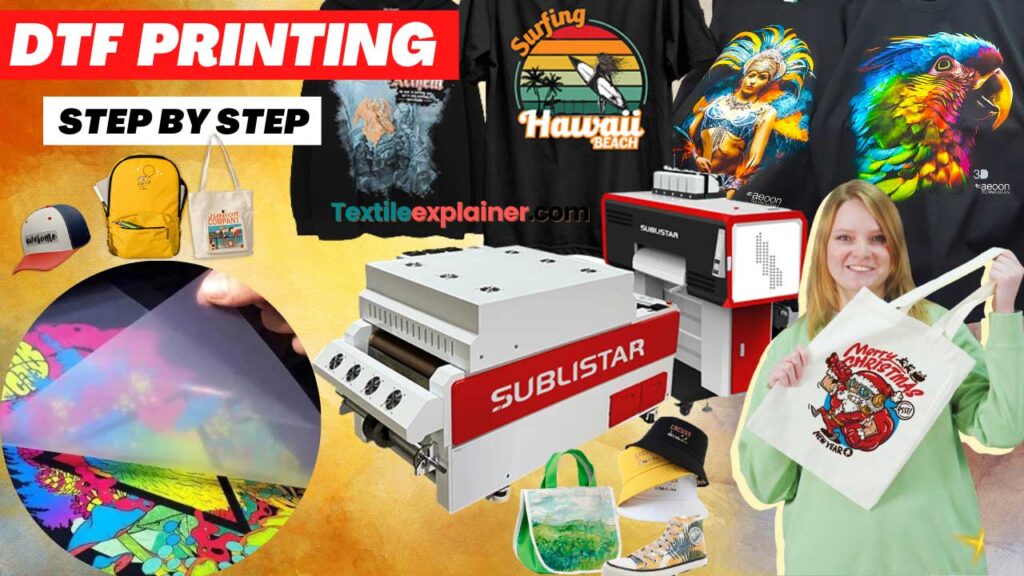The Future of Style: Exploring DTF Printing Technology in the Textile Industry
Recently, the fabric industry has seen a significant shift towards cutting-edge modern technologies that are improving the landscape of fashion production. Among these advancements, Direct to Film (DTF) printing innovation has become a promising competitor, offering special capabilities and opportunities for designers and manufacturers alike. This sophisticated printing technique has actually triggered interest because of its potential to change standard fabric printing processes. As we look into the effects and opportunities of DTF technology in the world of fashion, it ends up being noticeable that its assimilation can redefine market criteria and lead the way for a brand-new age of innovative expression and performance.
Evolution of Fabric Printing
From the old civilizations making use of techniques like block printing to the electronic transformation of today, fabric printing has constantly pressed borders. As the craft spread to various other parts of the world, new techniques such as display printing and roller printing emerged throughout the Industrial Revolution, changing the textile market.
The intro of digital textile printing in the late 20th century noted a significant change towards even more sustainable and versatile printing approaches. The advancement of fabric printing showcases an abundant background of creativity, resourcefulness, and technical development in the world of style and layout.
Advantages of DTF Technology
With the evolution of textile printing methods from ancient approaches like block printing to modern-day innovations such as digital printing, the introduction of Direct-to-Fabric (DTF) technology has actually considerably boosted the efficiency and sustainability of textile printing processes. Among the key benefits of DTF modern technology is its ability to straight print designs onto textile without the need for transfer documents, which reduces waste and simplifies the production procedure. Additionally, DTF printing enables higher shade vibrancy and detail accuracy contrasted to conventional techniques, enabling fabric suppliers to create premium and intricate layouts easily.
In addition, DTF innovation is recognized for its adaptability, as it can be utilized on various kinds of materials, including all-natural fibers like woollen, silk, and cotton, as well as synthetic products such as polyester and nylon (DTF Printing). This adaptability opens up a variety of possibilities for designers and producers to explore different textures and materials, bring about even more innovative and distinct items in the apparel industry. Generally, the implementation of DTF innovation represents a substantial development in fabric printing, supplying numerous benefits that add to the future sustainability and imagination of the industry
Sustainability in Style Manufacturing
Stressing environment-friendly methods is paramount in modern fashion manufacturing, aligning with the growing customer need for lasting items. Recently, the style sector has dealt with enhancing scrutiny as a result of its considerable ecological effect, including extreme water usage, chemical air pollution, and textile waste. As a reaction, numerous style brands are currently including lasting methods into their production processes to reduce harm to the atmosphere.
Sustainability in vogue production incorporates numerous elements, such as utilizing recycled and organic materials, lowering power usage, implementing honest labor practices, and promoting transparency throughout the supply chain. Furthermore, advancements in innovation, like DTF printing, offer chances to additionally improve sustainability in textile manufacturing. This innovation enables precise printing on materials, lowering ink wastage and water usage compared to standard printing methods.
Layout Liberty and Modification

Moreover, DTF printing assists in modification on a scale previously unattainable, enabling for customized clothes and one-of-a-kind items customized to individual choices. Generally, DTF printing modern technology reinvents the layout landscape in the textile sector, offering endless possibilities for innovative expression and personalized fashion.
Impact on Supply Chain & Market Trends
DTF printing innovation in the textile market is reshaping supply chain dynamics and affecting market fads via its efficiency and customization capabilities. By enabling on-demand printing and getting rid of the need for big inventories, DTF innovation streamlines the supply chain procedure. Manufacturers can produce things as needed, lowering waste and storage expenses. This just-in-time manufacturing version likewise enables quicker feedback to market needs and trends, causing an extra receptive and agile supply chain.
In addition, the customization potential of DTF printing innovation is changing the market trends in the textile sector. As an you can try here outcome, DTF innovation is driving a shift in the direction of more customer-centric and cutting-edge strategies within the fabric industry, forming the future of fashion.

Verdict
Finally, DTF printing modern technology is transforming the fabric industry by using countless benefits such as design sustainability, freedom, and customization. This cutting-edge modern technology is improving the future of style manufacturing, affecting supply chains, and driving market patterns towards more eco-friendly and effective methods. As the sector proceeds to advance, DTF printing will certainly play a crucial role in shaping the means fabrics are generated and eaten in the years ahead.
From the ancient people making use of strategies like block printing to the electronic transformation of today, fabric printing site web has continuously pushed borders. As the craft spread to other components of the globe, new techniques such as display printing and roller printing emerged throughout the Industrial Transformation, transforming the textile market.
The introduction of digital textile printing in the late 20th century marked a considerable change towards more lasting and versatile printing methods.With the development of fabric printing strategies from ancient techniques like block printing to modern advancements such as electronic printing, the intro of Direct-to-Fabric (DTF) technology has actually dramatically enhanced the efficiency and sustainability of fabric printing processes (DTF Printing).In reaction to the critical change in the direction of sustainability in fashion production, the adoption of cutting-edge modern technologies like DTF printing not just addresses environmental worries however also opens up avenues for exceptional layout liberty and modification in the fabric sector